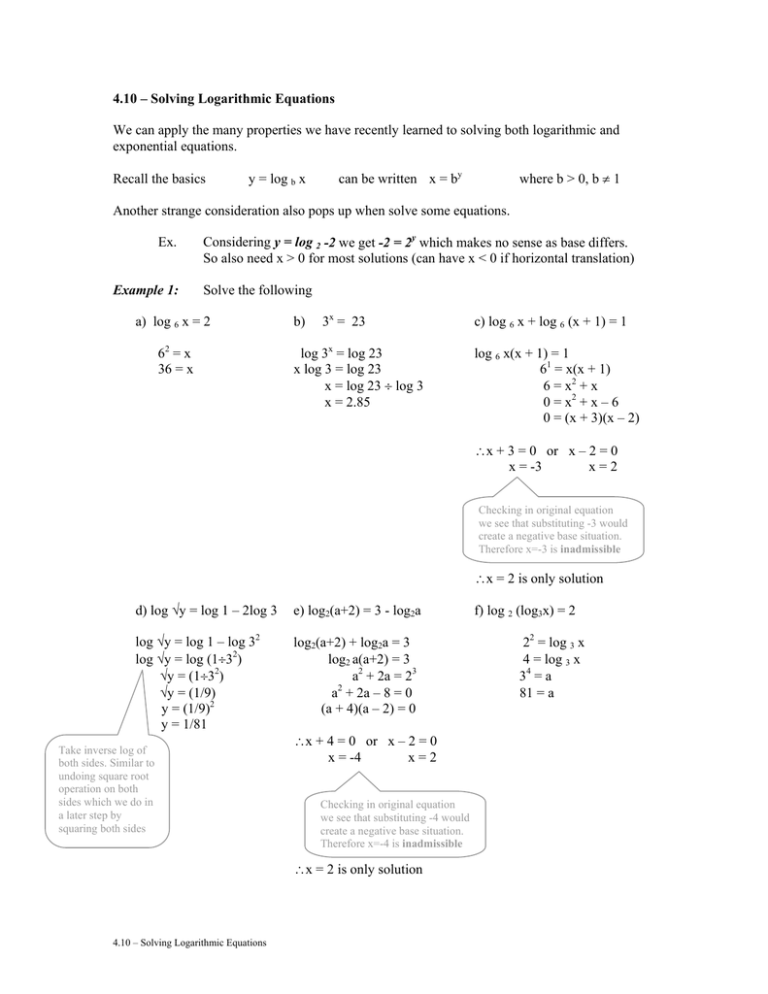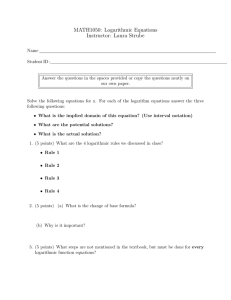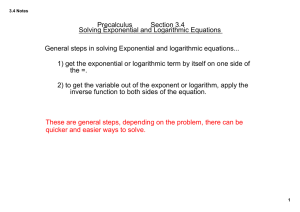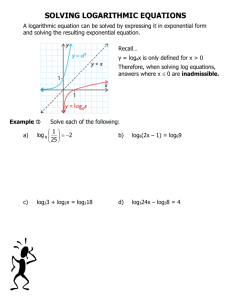4.10 – Solving Logarithmic Equations exponential equations.
advertisement

4.10 – Solving Logarithmic Equations We can apply the many properties we have recently learned to solving both logarithmic and exponential equations. Recall the basics y = log b x can be written x = by where b > 0, b ≠ 1 Another strange consideration also pops up when solve some equations. Ex. Example 1: Considering y = log 2 -2 we get -2 = 2y which makes no sense as base differs. So also need x > 0 for most solutions (can have x < 0 if horizontal translation) Solve the following a) log 6 x = 2 62 = x 36 = x b) 3x = 23 log 3x = log 23 x log 3 = log 23 x = log 23 ÷ log 3 x = 2.85 c) log 6 x + log 6 (x + 1) = 1 log 6 x(x + 1) = 1 61 = x(x + 1) 6 = x2 + x 0 = x2 + x – 6 0 = (x + 3)(x – 2) ∴x + 3 = 0 or x – 2 = 0 x = -3 x=2 Checking in original equation we see that substituting -3 would create a negative base situation. Therefore x=-3 is inadmissible ∴x = 2 is only solution d) log √y = log 1 – 2log 3 e) log2(a+2) = 3 - log2a log √y = log 1 – log 32 log √y = log (1÷32) √y = (1÷32) √y = (1/9) y = (1/9)2 y = 1/81 log2(a+2) + log2a = 3 log2 a(a+2) = 3 a2 + 2a = 23 2 a + 2a – 8 = 0 (a + 4)(a – 2) = 0 Take inverse log of both sides. Similar to undoing square root operation on both sides which we do in a later step by squaring both sides ∴x + 4 = 0 or x – 2 = 0 x = -4 x=2 Checking in original equation we see that substituting -4 would create a negative base situation. Therefore x=-4 is inadmissible ∴x = 2 is only solution 4.10 – Solving Logarithmic Equations f) log 2 (log3x) = 2 22 = log 3 x 4 = log 3 x 34 = a 81 = a 4.10 – Solving Logarithmic Equations Practice Questions 1. Solve the following: a) log 10 x = 2 d) log 2 2x = 0 g) log x 2 81 = 1 j) log x = 2 log 3 + 2 log 2 m) log 6 (x-1) + log 6 (x+4) = 2 p) 83x+1 = 642x s) log 2 x + log 2 (x+2) = 3 b) log 3 x = -2 e) log 5 10x = 7 h) log 2 8x = 3 log 2 x c) log 10 x = 2 log 10 5 f) log 6 x = 2 i) log 3 x = 4 log 3 3 k) log √x = log 1 - 2 log 3 l) 2x -1 = 4 n) log 2 (2x+2) - log 2 (x-1) = 3 o) 3 (2x) = 18 x-1 q) log 2 (x+2) = 3 - log 2 x r) -5x = 25 t) log 5 x + log 10 x = 5 2. It is said that a car depreciates 15% per year. Using this rate, how long will it be before a new car is worth half of its original value? 3. Hospitals using radioactive cobalt-60 in some of their medical treatments. When the radioactivity of the cobalt decreases to 45% they need to replace the cobalt with a new one. Given the half-life of Co60 is 5.24a, how often do they need to replace it? 4. In 1950 a towns’ population was 40000. In 2007 it was 80000. Estimate what the population was in 1980. 5. The half life of carbon 14 (C14) is about 5760. If a bone sample only has 5% C14 remaining, determine the age of the bone. 6. A 1950 silver dollar is a highly collectable coin. It was seen listed on e-bay for $500 last week. Calculate the annual rate at which this coin has appreciated. 7. A pot of boiling (100°C) water is removed from the stove to cool. Every 5 minutes the difference between the water and room temperature is reduced by 50%. a) Given the room temperature is 20°C, express water temperature as a function of the time, in minutes, since the pot was removed from the stove. b) How long will it take the water to cool to 30°C? Answers 1. a) 100 b) 1/9 c) 25 d) ½ e) 7/(log510)= 4.9 f) 36 g) ±9 h) 2√2 i) 81 j) 36 k) 1/81 l) 2.32 m) 5 n) 10/6 o) 1.82 p) 1 q) 2 r) no solution s) 2 t) 114.04 2. 4.25a or 4a & 3m 3. 6a 4. about 57600 5. about 24894 years old 6. ~11.5% 7. a) T(t)=80(0.5)^(t/5)+20 b) 15 minutes 4.10 – Solving Logarithmic Equations


